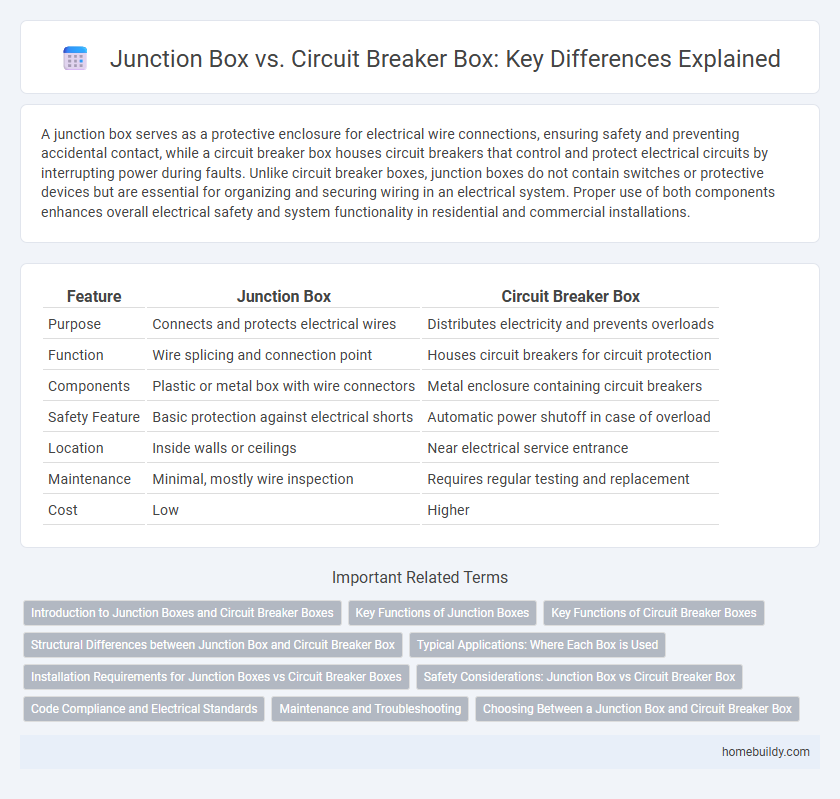A junction box serves as a protective enclosure for electrical wire connections, ensuring safety and preventing accidental contact, while a circuit breaker box houses circuit breakers that control and protect electrical circuits by interrupting power during faults. Unlike circuit breaker boxes, junction boxes do not contain switches or protective devices but are essential for organizing and securing wiring in an electrical system. Proper use of both components enhances overall electrical safety and system functionality in residential and commercial installations.
Table of Comparison
| Feature | Junction Box | Circuit Breaker Box |
|---|---|---|
| Purpose | Connects and protects electrical wires | Distributes electricity and prevents overloads |
| Function | Wire splicing and connection point | Houses circuit breakers for circuit protection |
| Components | Plastic or metal box with wire connectors | Metal enclosure containing circuit breakers |
| Safety Feature | Basic protection against electrical shorts | Automatic power shutoff in case of overload |
| Location | Inside walls or ceilings | Near electrical service entrance |
| Maintenance | Minimal, mostly wire inspection | Requires regular testing and replacement |
| Cost | Low | Higher |
Introduction to Junction Boxes and Circuit Breaker Boxes
Junction boxes serve as protective enclosures for electrical wire connections, ensuring safe containment and organization of wiring splices. Circuit breaker boxes, also called electrical panels or breaker panels, house circuit breakers that control and distribute electrical power across a building's circuits. While junction boxes manage wiring connections, circuit breaker boxes provide overcurrent protection and enable circuit isolation for maintenance and safety.
Key Functions of Junction Boxes
Junction boxes serve as protective enclosures where electrical wires are connected and organized, ensuring safe and reliable circuit continuity. Unlike circuit breaker boxes, which primarily control and protect electrical circuits by interrupting current flow during faults, junction boxes focus on joining multiple wires while preventing exposure to environmental hazards. Their key function is to provide a secure, accessible point for wire splicing and distribution without circuit control capabilities.
Key Functions of Circuit Breaker Boxes
Circuit breaker boxes serve as central hubs for electrical safety, housing circuit breakers that automatically interrupt power during overloads or short circuits to prevent electrical fires. These boxes distribute electricity to various circuits in a building, ensuring controlled and safe power management. Unlike junction boxes, which primarily join wires without interruption, circuit breaker boxes actively protect and regulate electrical flow.
Structural Differences between Junction Box and Circuit Breaker Box
A junction box is a compact enclosure designed to house electrical connections, typically featuring multiple knockouts to allow wiring from various directions and facilitating safe splicing and branching of wires. In contrast, a circuit breaker box, or panelboard, is a larger, more complex structure that contains circuit breakers or fuses along with bus bars to distribute and protect electrical circuits throughout a building. Structurally, the junction box is focused on connection and protection of wire splices, while the circuit breaker box incorporates switching, overload protection, and circuit organization capabilities.
Typical Applications: Where Each Box is Used
Junction boxes are commonly used in residential and commercial electrical installations to protect and organize wiring connections, ensuring safe and accessible junction points within walls or ceilings. Circuit breaker boxes, also known as distribution boards, are primarily installed to house circuit breakers that control and safeguard the electrical circuits throughout an entire building or facility. In typical applications, junction boxes facilitate wire splicing and branching in localized areas, while circuit breaker boxes serve as central hubs for managing and protecting multiple electrical circuits.
Installation Requirements for Junction Boxes vs Circuit Breaker Boxes
Junction boxes require secure mounting and proper wire management to ensure safe electrical connections in compliance with NEC standards. Circuit breaker boxes demand precise installation with grounding, correct breaker sizing, and accessibility for maintenance and safety inspections. Both installations must consider local electrical codes, but circuit breaker boxes have stricter regulations due to their critical role in system protection.
Safety Considerations: Junction Box vs Circuit Breaker Box
Junction boxes are designed to safely house wire connections, minimizing the risk of electrical fires by containing sparks and heat within an enclosed space. Circuit breaker boxes not only protect wiring connections but also provide critical overload and short circuit protection by automatically disconnecting power during fault conditions. Prioritizing a properly installed circuit breaker box enhances overall household safety by preventing potential electrical hazards more effectively than junction boxes alone.
Code Compliance and Electrical Standards
Junction boxes and circuit breaker boxes both play critical roles in electrical systems but adhere to distinct code compliance and electrical standards. Junction boxes are required to be accessible and properly sealed to protect wire connections per NEC Article 314, ensuring safe splices and minimizing fire risks. Circuit breaker boxes must meet UL listing requirements and be installed following NEC Article 408, with specific provisions for grounding, panelboard mounting, and circuit breaker coordination to ensure system protection and compliance.
Maintenance and Troubleshooting
Junction boxes require regular inspection to ensure wire connections remain secure and free from corrosion, which prevents potential electrical faults. Circuit breaker boxes demand routine testing of breakers and replacement of faulty units to maintain system safety and prevent power interruptions. Both components benefit from clear labeling and organized wiring to simplify troubleshooting and reduce maintenance time.
Choosing Between a Junction Box and Circuit Breaker Box
Choosing between a junction box and a circuit breaker box depends on the electrical system's purpose and safety requirements. A junction box primarily serves as a protective enclosure for wire connections, facilitating safe cable distribution without circuit protection features. In contrast, a circuit breaker box includes circuit breakers that safeguard electrical circuits from overloads and short circuits, making it essential for system protection and compliance with electrical codes.
Junction box vs Circuit breaker box Infographic

 homebuildy.com
homebuildy.com